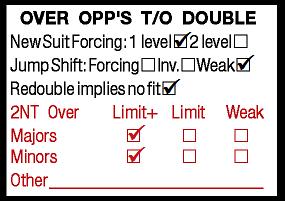Over Opps T/O Double

When we open 1 of a suit and the opponents make a takeout double, a redouble always shows 10+. After our redouble, any subsequent doubles are penalty. If the opener runs prematurely, he is showing a weak shapely hand (such as: 1 -(X)-XX-(2
-(X)-XX-(2 ); 2
); 2 ).
).
Examples:
| West | North | East | South | |||
|---|---|---|---|---|---|---|
1 | X | XX | 2 | |||
| Pass | Pass | X=Pen. |
| West | North | East | South | |||||||||
|---|---|---|---|---|---|---|---|---|---|---|---|---|
1 | X | XX | 2 | |||||||||
2 =Weak (6+ =Weak (6+ ) ) |
A new-suit on the 1-level is forcing one round. With a hand such as:  3
3 A Q J 9 8
A Q J 9 8 A 4 3
A 4 3 J 6 5 4
J 6 5 4
, after 1 -X, I'd rather get the hearts in at once (1
-X, I'd rather get the hearts in at once (1 ) instead of redoubling and being subject to preemption. Some 10+ point hands will have the option to go either way (either redouble, or bid at once).
) instead of redoubling and being subject to preemption. Some 10+ point hands will have the option to go either way (either redouble, or bid at once).
A new-suit on the 2-level is natural and non-forcing. (One of the system-upgrade options is available here). For example, 1 (X) 2
(X) 2 shows something like:
shows something like:  43
43 32
32 Q32
Q32 AQ9864
AQ9864
(the hand is limited by the failure to redouble).
This treatment of NF on the 2-level and forcing on the 1-level is by far the most common worldwide (not something special to LC Standard).
Jump shifts are weak [example: 1 (X) 2
(X) 2 ].
].
Jump raises are weak [example: 1 (X) 3
(X) 3 ].
].
A jump to 2NT after their double is artificial. It shows a limit raise or better. After 1 (X) or 1
(X) or 1 (X) the 2NT bid shows 3+ trumps (and 10+ in support). After a 1
(X) the 2NT bid shows 3+ trumps (and 10+ in support). After a 1 opening, it shows at least 4 trumps and after a 1
opening, it shows at least 4 trumps and after a 1 opening, at least 5.
opening, at least 5.
For a full LC Standard Convention Card and a prettier version of this series, see Bridge Winners.